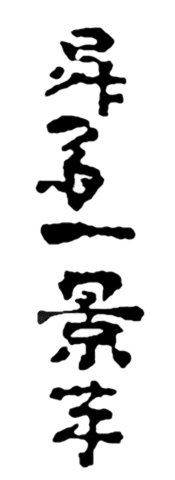| |
Shōsai Ikkei
|
 |
 |
| Shōsai Ikkei 昇斎一景筆 |
Shōsai Ikkei
hitsu
(painted by
Shosei Ikkei) 昇斎一景筆 筆 |
Artist – Shōsai
IKKEI (昇斎 一景) was living in Edo, and said to be a disciple of
Utagawa Hiroshige-III. His surname is unknown. At first he
used the epithet Keishosai (景昇斎) and later on Shosai (昇斎). There is a theory that he was
the posthumous of Utagawa Hirokage, also a disciple of Utagawa
Hiroshige ( 歌川広景) . There is also a painter named Isshosai
Kokufuku 一昇斎国福 (Utagawa Kunifuku, 歌川国福 ), who has a name that
connects Hirokage and Ikkei. The only document that mentions
this one view is the introduction written by Yuto Santei in
the table of contents of "Forty-Eight Famous Views of Tokyo''.
According to that article, IKKEI at one point he traveled to
Kyoto to study the Shijo school , admiring Maruyama Okyo.
Later on, he quit painting and lived a life of avoidance. In
the Meiji era, he once again began to draw caricatures and
nishiki-e at the request of Shobo (書房) printshop and editor.
Therefore, it is thought that Hirokage or Kokufuku studied in
Kyoto at the end of the Edo period and resumed painting in
Tokyo after the Meiji Restoration.
The painting period was short, ranging only from late 1860ies to 1874, and it is believed that he died young. He painted many customs and landscapes in the early Meiji period. The total number of his works is unknown, but 34 triptychs, 98 single prints, and 6 booklets / folded books have been confirmed. His most representative works are "Forty-Eight Famous Views of the Eastern Capital'' (Tōkyō meisho Shitoya kei, 東京名所四十八景) dated from 1871, and "Thirty-six Famous Places in Tokyo'' (“Tōkyō meisho sanjurokugisen” 東京名所三六戯撰) from 1872-73. In addition, there are several humorous genre paintings, landscape paintings, triptychs of famous places in Tokyo, and nishiki-e with modern achievements such as railways, electricity, gas supply, and so on. His painting style was somehow similar to Utagawa Hiroshige III, but at the same time as depicting people, he accurately captures the customs and atmosphere of the times. Since IKKEI's woodblock prints have been created in the early Meiji period, they may be seen as a valuable material to estimate the extent to which the civilization and enlightenment led by the Meiji government has penetrated the people.
Personal
life - There is nearly no personal information about his
life.
Aliases - His artist's names include Shōsai IKKEI (昇斎 一景) as his main go, as well as Isshōsai( 一昇斎), and Keishosai (景昇斎) as another epithet
Disciples - no known disciples
Copyright 2008 ff: Hans P. Boehme